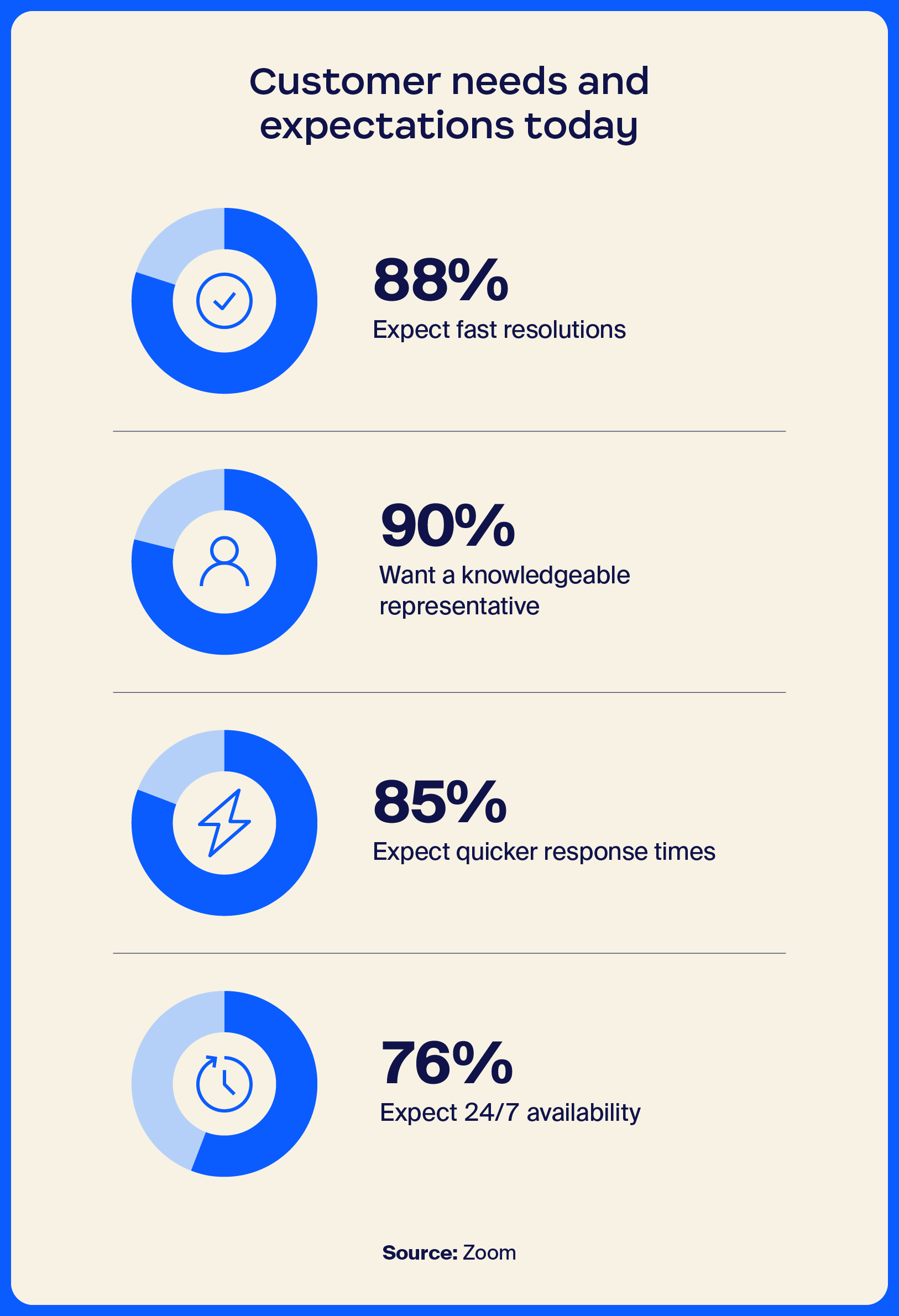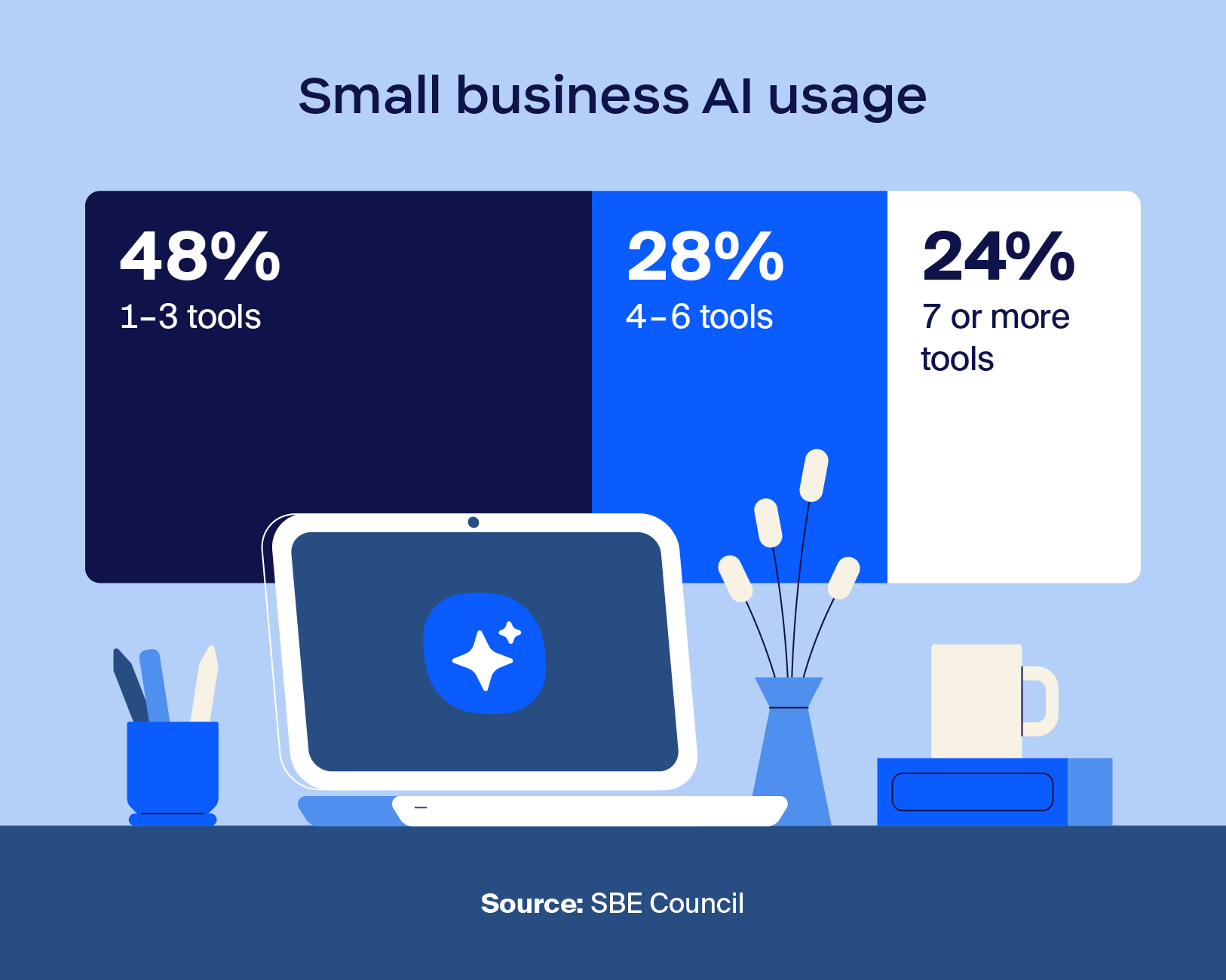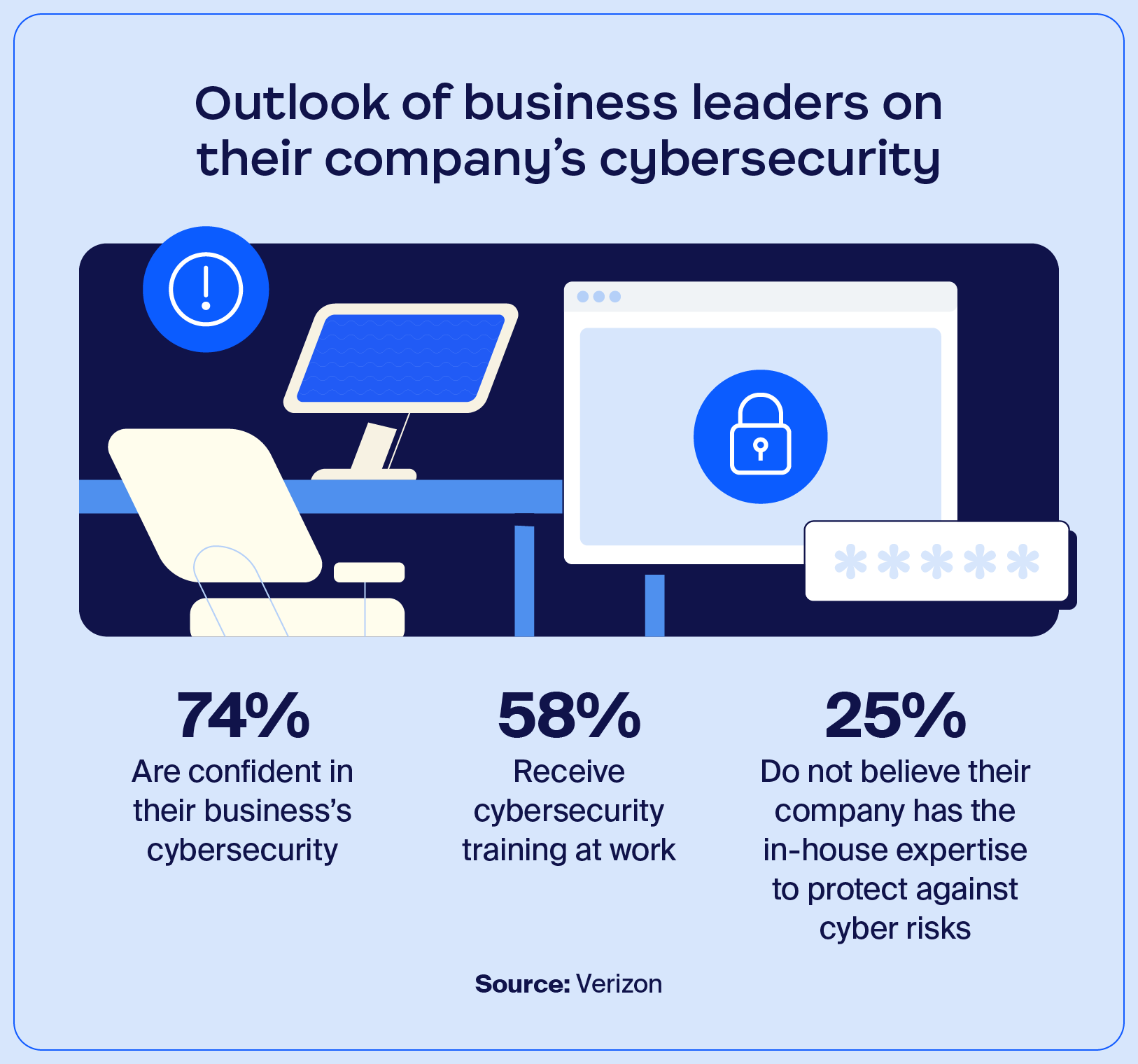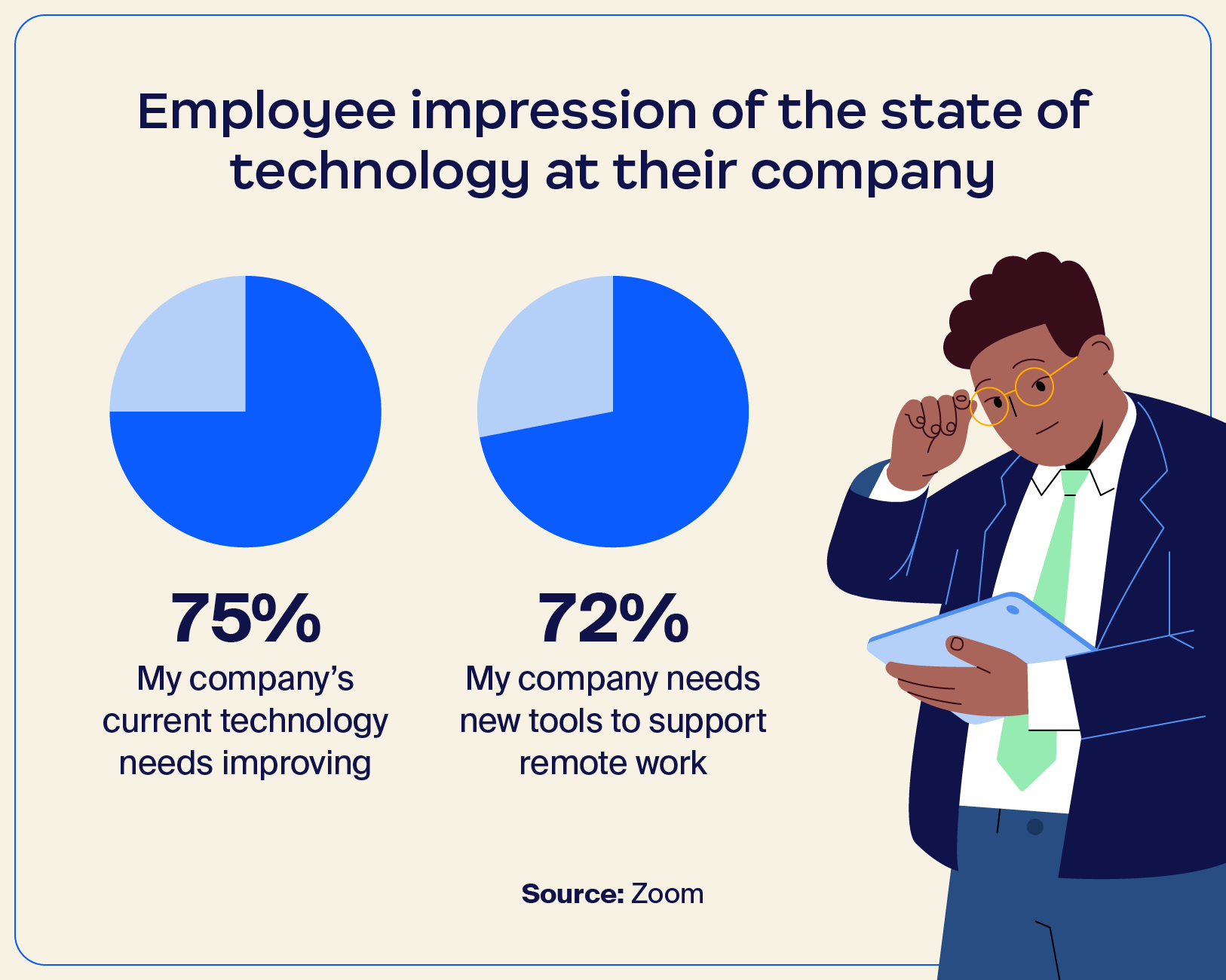
Meet Zoom AI Companion, your new AI assistant!
Boost productivity and team collaboration with Zoom AI Companion, available at no additional cost with eligible paid Zoom plans.
Explore the latest small business tech trends in areas like artificial intelligence and hardware innovation to keep your business ahead of the curve.
Updated on January 14, 2025
Published on January 14, 2025


Between increased competition and changing customer expectations, every small business needs to evolve alongside its competitors and stay ahead of the curve. Embracing new technology is one way to do that. From unified communication platforms to AI tools, technological advancements are changing how we work.
We explored recent data, conducted our own research, and consulted our in-house experts to round up the trends shaping small business technology as we enter 2025.
AI adoption has grown rapidly over the past few years for both employees and leaders. Two thirds of small business owners surveyed by The SMB Group say that AI has already had a very big or modest impact on their businesses to date, with more than three-quarters expecting this level of impact in two years.
Consider how AI has become a part of our daily routines: chatbots that assist with customer service, personalized recommendations on streaming platforms, the route optimization behind ride-sharing apps, and even the virtual backgrounds and noise suppression features in video conferencing tools like Zoom.
These are just a few examples of how AI has grown over time from a buzzword to a variety of tools revolutionizing industries and improving our lives. These days, AI tools like Zoom AI Companion can analyze vast amounts of data to:
Summarize documents: Instead of dedicating a large amount of time to summarizing documents, you can leverage AI tools to generate summaries in a fraction of the time.Take automated and detailed meeting notes: Meetings can be stressful without the added responsibility of note-taking. AI can automate that task so that you can focus on the conversation at hand.
Our research found that 84% of leaders believe that AI has had a positive effect on their organization’s productivity. AI tools such as those used for automation, decision-making processes, and other time-saving tasks can help businesses with their productivity.
“Small businesses are gravitating toward tools that help them do more with less so that they can focus on what matters”
— Beth Cananzi, Solutions Marketing Manager, Small and Midsize Business at Zoom
Despite advancements in small business technology like AI, there’s still a strong need for human involvement in customer service. AI can handle certain tasks, but it can’t fully replace the empathy and understanding that humans bring to customer experience.
Customers want a personal connection, from the first interaction to troubleshooting and issue resolution. Our recent research commissioned by Zoom and conducted by Morning Consult revealed that 89% of respondents expect agents to be friendly and 90% expect them to be knowledgeable. This suggests that while AI can do a lot for the customer experience, it should not replace human interaction altogether.

In recent years, the cost of AI technology has dropped significantly, making it more accessible to small businesses. A survey from October 2023 found that the average small business utilizes four AI tools, with nearly a quarter (24%) employing at least seven tools. This indicates a growing trend of AI adoption among SMBs (small and medium-sized businesses).
This is largely due to advancements in hardware innovations, cloud computing, and open-source platforms. For one, the hardware that’s capable of handling AI functionalities is cheaper and more accessible than ever before. It’s also important to note that flexible payment models offered by cloud solutions make it easier and more affordable for small businesses to break past the cost barrier. Additionally, AI tools aren’t as expensive to make as they used to be, with techniques like transfer learning — in which AI models draw knowledge from pre-trained models — contributing to lowering the overall cost of AI solutions.
The availability of affordable AI tools and platforms has made it easier for SMBs to experiment with and implement AI solutions. Cloud-based AI services like Zoom AI Companion offer a flexible and cost-effective way for businesses to access AI capabilities without significant upfront investment. In fact, Zoom AI Companion is available at no additional cost with paid Zoom plans*.
*AI Companion may not be available for all regions and industry verticals

“AI-powered search, which is something we have in Zoom, searches not just your chats. It searches everything: the docs you've made, your meeting summaries, your recording transcripts, and more. It’s really helpful for small businesses who don’t have time to go rifling through different files to find where things are stored.”
— Beth Cananzi, Solutions Marketing Manager, Small and Midsize Business at Zoom
Cloud contact center software has experienced significant growth in the past five years, transforming the way businesses interact with their customers. This shift is driven by several factors, including the desire for greater flexibility, scalability, and cost-effectiveness. The cloud contact center market is projected to reach $82.43 billion by 2030, a CAGR (compound annual growth rate) of 21.3% from 2022 to 2030.
Cloud-based solutions offer businesses the ability to quickly scale up their operations to meet changing customer demands, while also reducing the need for significant upfront investments. Cloud contact center software makes it easier than ever for SMBs to offer robust customer service, including self-service and live chatbots, advanced call queues, and scheduled callbacks, that used to require a significant on-prem investment. This means contact center-style service with up to 24/7 coverage is no longer exclusive to larger businesses.
Streamlined processes are also a key factor driving the adoption of cloud contact center software among other new technologies, as SMBs are increasingly seeking solutions that can simplify operations and meet their long-term needs. According to Forbes, 83% of small business leaders say using tech to streamline tasks fosters more certainty in planning and decision-making, with 80% saying they will significantly invest in cloud technology in the next 3 years.
Tech for small businesses goes beyond operational productivity and generative AI tools. Despite the growing threat of cyberattacks, many small businesses remain vulnerable to security breaches. While nearly a quarter of SMB owners and decision-makers (74%) are at least somewhat confident in their current cybersecurity measures, only 58% say their business offers employees cybersecurity training. This indicates a significant gap between perceived security and actual preparedness.
Small businesses are particularly attractive targets for cybercriminals due to their often-limited resources and security measures. Attackers may exploit vulnerabilities in their IT infrastructure or employ phishing scams or social engineering tactics to gain unauthorized access to sensitive data.
The consequences of a cyberattack can be devastating for a small business, including financial loss, reputational damage, and operational disruption. It’s essential for SMBs to choose communication and collaboration tools from trusted providers that prioritize cybersecurity, and invest in measures to protect themselves from these threats.

The increase in remote and flexible work has created a surge in demand for collaboration, communication, and productivity technology.
The global collaboration software market is projected to grow from $5.8 billion to $19.86 billion between 2022 and 2032, a CAGR of 13.1%. This growth is driven by factors such as the increasing popularity of remote work, the rising adoption of cloud-based collaboration solutions, and the growing need for real-time communication and collaboration tools.
Remote work demands that businesses have the right tech to help teams work together, even when physically apart. Tools like video conferencing, team chat, and project management software have become essential for maintaining productivity and fostering a sense of team cohesion.
For small businesses in industries like retail and hospitality where remote work is less common, unified communication software on mobile devices helps business owners keep their necessary contacts, notes, and even documents at their fingertips when on the go.

While the importance of customer-centric technology can’t be overstated, many small businesses are prioritizing investments in operational efficiency tools. This reflects a focus on streamlining processes, improving productivity, and reducing costs.
A 2022 survey found that 61% of respondents whose companies upgraded existing parts of their communication technology stack in the previous year primarily focused making operations more efficient.
While customer-centric technologies are also valuable, SMBs may prioritize operational efficiency tools as a foundation for building a strong business before investing in stronger customer experience (CX) tools.
Nine in 10 SMB owners and decision-makers (84%) expressed concern about the state of the U.S. economy in August 2024, highlighting widespread anxiety surrounding the economic landscape. Additionally, more than four in five business leaders are concerned about the impact of the current economic conditions on small businesses in the U.S. and the global economy.
Despite these broader economic concerns, only 54% of business leaders feel concerned about their own job security. This suggests that while individuals may be apprehensive about the overall economic situation, they remain relatively confident in their own employment prospects.
Hardware advancements are playing a crucial role in supporting the development and widespread adoption of AI.
“AI is happening right now. So when we’re talking about emerging technologies, we’re looking a little bit further down the road. Some really exciting things are happening in the semiconductor industry, with more powerful chips that run faster and require less power. That’s going to further democratize the cost of AI.”
— Beth Cananzi, Solutions Marketing Manager, Small and Midsize Business at Zoom
Hardware vendors are beginning to develop AI PCs, adding neural processing units to the computer to support the graphics processing unit (GPU). For small business owners, this means equipment that is more performant and better suited to run AI applications. As the hardware systems to support AI become more mature, this will also help decrease the cost of AI, making it more accessible.
The past couple of years have set the stage for an exciting future in small business technology. Collaboration solutions, customer support tools, and AI-powered features are set to transform the workplace even more. Find out how Zoom Workplace can help your business stay on track.
Here are some frequently asked questions small business owners may have as we head into 2025.
Small businesses need a well-structured tech stack that includes communication and collaboration tools (email, video conferencing, chat, project management software), customer relationship management software, accounting and financial tools, marketing automation tools, cybersecurity tools, and more.
A few technology trends impacting businesses today are the growth of AI tools, the rise of cloud-based solutions, and hardware advancements to accommodate AI.
The critical technology for your business in the next six months will depend on your specific needs and goals. But some emerging technologies to consider include AI-powered chatbots, AI-powered search, and robust collaboration software.
An IT strategy is a roadmap that outlines a small business’s technology goals and how to achieve them. It should include a technology needs assessment, budget allocation, security measures, and implementation plans.